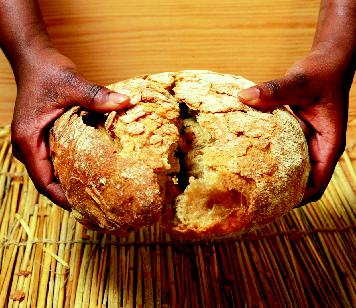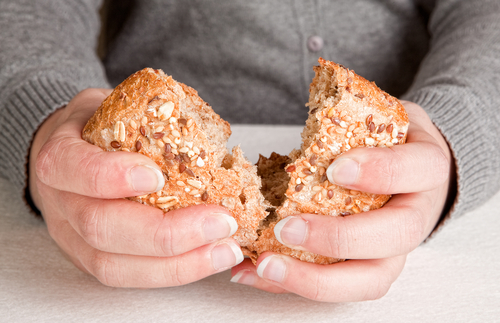Tags
acne aging anti-aging beauty detox diet exercise fasting healing health healthy lifestyle healthy living healthy recipes inspiration juicing Living la Vida Raw meditation mindfulness Move Your Body Natural Beauty natural cures Natural Cures natural remedies nutrition nutritionist parasites raw raw food Raw Food for Thought raw foods raw girl Raw News raw recipes Raw Spirit Recipes skin spirulina stress vegan vegan lifestyle vegan recipes vegetarian Veggie Love wellness yogaNewsletter Sign-up
Tag Archives: healthy living
Breaking BreadUnderstanding How Wheat (and Gluten) Hurt Our Bodies, Part II
Issue #2 – gluten’s effect on the brain. Gluten is the only grain protein which, when digested into polypeptide chains, crosses the blood brain barrier. This is true for both the new “dwarf” wheats as well as the heritage wheats. And what does it do in the brain? Among other things, these gluteomorphins lodge in the endorphin receptor sites, causing . . . you guessed it! Euphoria. Mild euphoria for some, greater for others, but euphoria nonetheless. And so gluten in wheat is addictive. It can be subtle; all people know is that they crave certain foods – if you pay attention, many of the foods that are craved contain wheat and gluten. This craving side effect of eating wheat in people with normal brain activity leads to weight gain and the development of diabetes.
This is bad enough, but in people with different brain activity such as ADHD symptoms or autism symptoms, or even schizophrenia, the gluten in wheat can cause great exacerbation of symptoms. So psych wards which have removed wheat have seen tremendous calming of hallucinations and delusions only to have them get worse again when wheat is added back into the cafeteria food, for example. And children with autism show much more stimming activity when wheat is consumed.
Issue #3 – gluten’s effect on the intestinal tract. Consumption of gluten leads to higher production by the body of a protein called zonulin, which loosens the tight junctures in the intestinal lining. A tightly woven intestinal lining is what keeps undigested food from going into the abdominal cavity and ending up in the bloodstream, where they elicit immune responses. Essentially, eating gluten results in a leaky gut, especially in those who already have impaired digestion, and this can lead to autoimmune disorders as described at the beginning of the article. Although people tend to associate Celiac Disease and gluten sensitivity with digestive symptoms, rarely do people realize that zonulin is doing its dirty deed in their intestinal tract even if they are not sensitive to gluten.
Another thing that people don’t usually realize is that most of the devastation caused by ingestion of wheat is not digestive, and because most people think wheat issues mean digestive problems, many people affected by wheat are currently experiencing symptoms that are “mysterious” – unrecognized and untreated. There is a huge educational campaign currently under way in the medical community, both holistic and conventional, to correct this misunderstanding.
Issue #4 – gluten’s effect on weight gain and the development of diabetes. The type of starch in wheat, amylopectin A, is different from the starch in things like potatoes, beans, and other grains, and one of its characteristics is that it is very easily digested. Although this sounds like a good thing, in fact it is not, because what it means is that the starch in wheat is immediately converted to glucose and raises blood sugar quickly. When blood sugar is raised quickly in the body, the body sees it as dangerous and immediately over-secretes insulin to get the glucose level down. But why does it over-secrete insulin, you ask. Well, the pancreas’ job was never to balance your blood sugar – it was to store energy in fat tissue for lean times. But we make the pancreas balance our blood sugar – it obliges, but unfortunately it does so in a very primitive way. It tends to overreact and secrete so much insulin that our blood sugar then falls quickly, which is a different kind of emergency for the body.
At this point the adrenal glands get involved and shoot out adrenaline and direct the body to take glucose back out of storage and dump it into the blood stream again, and here we are on the blood sugar roller coaster. When we do this for enough years, the pancreas, liver, and adrenal glands take a big hit, and we develop either severe hypoglycemia or insulin resistance, or diabetes, or all of the above in succession. What happens to us depends on which of our organs is weakest genetically, which has been hit hardest by our habits, and whether we change our habits.
The lesson to draw from all of this is that wheat and gluten are dangerous for everyone, not just for people with wheat sensitivity, and this is true whether you are eating new wheats or heritage wheats, although more so for new wheats. The good news, though, is that it is easy to live without gluten, and it exposes people to new foods. Not to sound cliché, but every problem is an opportunity!
– Babette
To learn more about Babette, click here
Sweet Surrender
What happens when you let go? When you completely let down your guard in practice? Authenticity does. When you invite yourself entirely to your yoga practice, you are able to show up in a way that will serve you and see things you would not generally see on a normal basis. Surrender. Along with strength and flexibility comes surrender. In yoga this is something we often look over however it is just as, if not more important than the other components. If we relinquish control and release expectations, we get exactly what it is that we need. Our body speaks to us clearly but it is up to us to listen. Step into your authenticity and receive your message.
~ Sihnuu Hetep
To learn more about Sihnuu, click here
Breaking Bread: Understanding How Wheat (and Gluten) Hurt Our Bodies, Part I

Photo from jaymuia.files.wordpress.com
I often say, “If I were queen of the world, no one would eat wheat. Ever.” This gluten-free thing that looks like a fad is not a Celiac issue, nor a gluten sensitivity issue only – it is an issue for everybody. Even if you have never had problems with wheat before, you could suddenly develop an autoimmune or neurological disorder from eating the “new wheat,” which are 99% of the wheat on the market today. Eating wheat is like playing Russian roulette with your health.
Not convinced? Let me fill you in. I love this particular food story, because it reads like a soap opera. The story of dairy is interesting (read The Untold Story of Milk), and the story of corn is too (read The Omnivore’s Dilemma) but I have to say that the story of wheat definitely takes the cake (read Wheat Belly by Dr. Davis and Grain Brain by Dr. Perlmutter). These are the best books on these topics. You can also google “gluten summit,” an online event that was just held with many world experts in the field of wheat/gluten and health.
Although many RawGirlToxicWorld readers are already gluten-free, I dare to guess that many of your friends and family are not. You need to let them know this story, so they pay attention. This story needs to be told to avoid unnecessary suffering. Send your peeps one of the books for Christmas to show your love.
The story reads like a soap opera because hybridization of wheat started off very well intentioned with efforts to make Mexico self-sufficient agriculturally and eradicate world hunger. In 1943 Mexico’s International Wheat and Maize Improvement Center partnered with the Rockefeller Foundation and brought in top agricultural geneticists to increase the yield of main crops. In the case of wheat, the tall stalk started buckling when use of nitrogen fertilizers after World War II led to heavier seed heads. The solution, developed primarily by Norman Borlaug, who won the Nobel Peace Prize for his work on wheat in 1970, was to develop a thicker, shorter stalk. This newer, shorter wheat was able to lead to increase wheat yield by eight to tenfold and helped to lessen world hunger dramatically in the 1970s.
The problem? These new dwarf wheats were never tested for safety, even though there had been significant altering of the genetic material. And so today we have a worldwide experiment going on, and we are seeing an unprecedented rise and exacerbation in health issues that seem to be connected to the consumption of the “new” “dwarf wheat” including skin problems; neurological issues; mental health disorders; obesity, diabetes and heart disease; and – of course – digestive problems.
Issue #1 – wheat gluten’s effect on the immune system. The reason consumption of wheat can trigger autoimmune disease out of the blue for anyone is because wheat has been hybridized at an accelerated pace over the last 70 years and this has resulted in freak proteins in the “new wheat”. When one grass is mated with another, 95% of the offspring proteins are the same as from one or the other parent plant – but 5% of the protein is new. So mating grasses over and over again has resulted in completely new proteins that the immune system has never seen. Plus, some very strange techniques have been used to make wheat mutate, such as use of radiation.
When the immune system is exposed to too many “foreign” particles in the bloodstream, it tends to go a little hyper and haywire. It also has a tendency to attack its own body tissue. This is why leaky gut can also lead to autoimmune disease. By the way, it allows incomplete digestion and therefore cause foreign-seeming food particles into the blood stream. This makes the immune system trigger-happy over time, leading to misfirings and autoimmune attack.
But that’s another article! The point here is that we have messed with wheat so much and in so many ways that it is completely different from the wheat that was consumed all through human history until the 1950’s.
If you have lab results definitively showing no wheat intolerance or genertic markers for it, you can theoretically eat heritage wheats like einkorn, emmer, and spelt. However, all wheats whether old or new have three characteristics which are not supportive of health. Stay tuned for Part II of Breaking Bread – Understanding how Wheat (and Gluten) Hurt Our Bodies.
– Babette
To learn more about Babette, click here
Part 3 – Why Fad Diets Don’t Work
 The deeper I get into my study of nutrition the more I have come to embrace bio-individuality as the best term to sum up my personal beliefs about healthy eating. You may have heard the saying “one man’s food is another man’s poison.” Well, bio-individuality is the concept that best summarizes this because it is essentially saying there is no one perfect way of eating for everyone. Every single human being, including you and I, have unique genetic make-ups, blood types, ancestry, metabolism, and food intolerances.
The deeper I get into my study of nutrition the more I have come to embrace bio-individuality as the best term to sum up my personal beliefs about healthy eating. You may have heard the saying “one man’s food is another man’s poison.” Well, bio-individuality is the concept that best summarizes this because it is essentially saying there is no one perfect way of eating for everyone. Every single human being, including you and I, have unique genetic make-ups, blood types, ancestry, metabolism, and food intolerances.
Part of your job, when walking the healthy living path, is to be your own health guru and figure out what makes your stomach and your body happy and healthy. Some bodies metabolize carbs better, and some proteins. Some people cannot be optimally healthy on an animal based diet or diet that includes dairy. Some people may not thrive on a vegan or raw diet, either because of improper supplementation, eating a diverse group of foods, or because their body is simply not getting the levels of essential nutrients or fat soluble vitamins it needs to function at its best. When this happens individuals find themselves with candida imbalances, tooth decay, fatigue or other signs that something is off-balance in the body.
I am a firm believer that optimal health should always be the end goal, and sole focus. This means that rather than clinging to a diet like a religion that leads to illness and eventually disease, each of us should carefully mine the information we hear about different food choices and diets and filter out by testing on our own body, and discovering what is appropriate for us. So how do we avoid falling into the fad diet trap?
As the ancient Egyptians put it: “Know thyself.” You have to know your ancestry, learn what foods your body does and does not like, and decipher what any imbalances that arise are trying to tell you. Most doctors can’t do this for you. It takes some personal initiative and perhaps some digging with the help of non-traditional and traditional health practitioners along with a nice dose of intuition. But when you put in the work it’s well worth it. My idea of a healthy and balanced world is one is which bio-individuality is embraced fully, where all of us avoid the factory and embrace the field, and where dietary labels don’t need to exist because everyone eats whole fresh good karma foods that support their unique and incredible body. -XoXo Raw Girl
Click to read Part 1 and Part 2 of Make Your Health Your Best Accessory.
The Healing Benefits of Tree Pose
Muscle tone in your legs is one of the first things to go when you have a sedentary, computer-centered life. That is why it so good to get up from your laptop every few hours and stand in tree pose.
Vrikshasana, in its call for balance and poise, tones the leg muscles, strengthens the spine and increases flexibility in the feet. A great pose for core building, Tree will increase your coordination, teach you patience and calm your mind.
Like a tree’s trunk you become rooted in your sense of self and grounded with conviction, while also expressing freedom, expansion and a heavenward gaze like the branches and leaves. Hunching over at your desk is commonplace I know, but the spine wants to fully extend, as does the spirit. Open your shoulders with Tree pose to increase your range of motion and improve posture.
Daily practice of this asana will bring waves of inner strength, self-confidence and peace to balance the fast-paced excesses of modern life.
– Sia
To learn more about Sia, click here
5 Foods and Beverages You Should Avoid Like the Plague
Soda: Sodas used to contain 9 teaspoons of sugar, which is an enormous amount to consume, especially on an empty stomach. But sodas today are sweetened with an equivalent amount of high fructose corn syrup (HFCS), which leads to obesity and fatty liver disease ( aka non-alcoholic cirrhosis of the liver) because it is not used like sugar by the body, but rather gets stored as fat. On top of the HFCS, sodas contain phosphoric acid, which cause calcium to be leached from your bones, teeth, and soft tissue, setting you up for osteoporosis, cavities, arthritis and other disease states.
What to do? Drink home-made herbal iced tea sweetened with stevia or sparkling mineral water with lemon/lime or plain coconut water, or try kombucha, a delicious, fermented carbonated beverage with liver-detoxifying properties that you can buy or make at home.
Grain-fed beef from CAFOs: What is grain-fed beef from CAFO (concentrated animal food operations)? It is the beef you eat in 99% of all restaurants and at home. It is also the beef from cows that have been fed an unnatural diet of corn and animal by-products in cruel, unsanitary and disease-causing environments. The meat from these cows is void of conjugated linoleic acid (CLA), a potent protector from cancers. The meat also has the wrong omega 3 to omega 6 ratio, causing inflammation in the body. It is low in riboflavin and other important B vitamins as well as having less Vitamin E, Vitamin K, and trace minerals like magnesium, calcium, and selenium.
What to do? If you want to eat beef, eat 100% grass-fed beef from health food stores, organic butcher shops and from local farm buyers’ clubs – go to www.eatwild.com and check out their directory.
Processed snacks and baked goods: What kind of snacks are we talking about? It’s the candy bars, Oreos, muffins, pastries, Cheez Whiz, and chips. Most processed snacks contain trans fats of some kind. Trans fats get incorporated into your cell structures when you eat them and take two years to cycle out. The incorporation of trans fats into cell walls leaves them incapable of important chemical reactions. As a result, there is chaos and dysfunction on the cellular level. Over a period of time, this leads to cancer, heart disease, diabetes, immune dysfunction, disrupted fetal growth, and obesity.
What to do? Eat whole fruit/veggies and cheese or hummus for snacks, as well as raw and unsalted nuts, plain yogurt (sweetened with stevia if you like), and home baked goods made from almond flour.
Juice: You were always told that fruit was good for you, and what is fruit juice but lots of fruit? So it must be very good for you, right? Wrong! Commercially produced juice has relatively little vitamin and mineral content, and it has had all the fiber taken out, so it sends your blood sugar sky high without giving you much of anything in return. It causes over production of insulin and weight gain, and also causes sugar crashes with accompanying energy lows, inability to think, and mood swings including irritability, anger, anxiety and sadness – yuck! As if impaired mental function weren’t enough, all of these symptoms are just little steps on the road to diabetes – nothing to laugh about.
What to do? Drink herbal iced tea sweetened with stevia or sparkling mineral water with lemon/lime or plain coconut water, or try kombucha, a delicious, carbonated fermented beverage with liver-detoxifying properties. You could also enjoy freshly squeezed vegetable juices with small amounts of fruit added in, and very occasionally treat yourself to fresh-squeezed straight fruit juice if you want, but have it with protein and fat to limit the effects of.
Cereal: All cereals except granola and muesli are extruded at extremely high temperatures (over 500 degrees Fahrenheit), altering the molecular structure of the grains in the slurry and burdening your body, which doesn’t know what to do with this strange food. Add in sugar or aspartame, food dyes, preservatives, and the worst quality commercial vitamins sprayed onto it, and you have an extremely artificial food that gives your body no real nutrients and all the burden of figuring out how to incorporate it. According to Paul Stitt, biochemist and industrial food critic, in an unpublished study conducted by a cereal company, lab rats lived two weeks only when given a diet of extruded cereal, while rats given only water lived significantly longer. In spite of all the marketing around it, as revealed by the autopsy in this study and others, the truth is that extruded cereal is terrible for your body, leading to dysfunction of the pancreas, liver and kidneys and degeneration of the nerves of the spine, all signs of insulin shock.
What to do?If you must have cold cereal, eat granola or muesli in plain yogurt and add raw, unsalted nuts and fresh fruit.
– Babette
To learn more about Babette, click here
Juice! Tangy Cucumber Cooler
I’m on a sugar-free regimen for the entire month of November, and it is in one word HARD. We are so used to being stimulated by sugar in so many forms, it is hard to function without it. In fact, the majority of us are so sugared-up that it leads us on the path to chronic illness and disease.
It is estimated that the average American eats 150 to 170 pounds of sugar each year. That’s the weight of an adult human being! No wonder so many are obese or sick and tired. Take stock of how much sugar you are putting in your body from morning to evening and you may be surprised. It’s in everything from condiments, processed foods, and “health drinks.
” Yes, our body needs carbohydrates to thrive and to give us energy, but it does not need refined sugars found in processed foods, desserts, and candies. Juicing is a great way to break addictions, and help the body reset from unhealthy cravings. Below is a recipe for a simple healthy juice with no added sugars, that is light and refreshing. -XoXo Raw Girl
Tangy Cucumber Cooler
1 head of Romaine
2 Cucumbers
1 Lemon
ginger root (to taste)
Run all ingredients through juicer. Strain, serve, enjoy!










